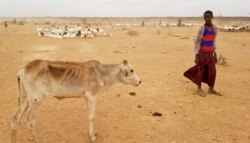Severe drought is affecting more than three million people in Somalia and southeast Ethiopia, says the aid group International Rescue Committee (IRC). The IRC says the two Horn of Africa nations are among 20 countries in the world most at risk for a worsening humanitarian crisis this year.
Ethiopia and Somalia are among 20 countries on the International Rescue Committee’s emergency watchlist for 2022.
Richard Crothers is the IRC country director for Somalia. He said the humanitarian situation in the two countries is not good.
“The Horn of Africa has been on the verge of crisis for some time. There have been several failed consecutive rainy seasons. We have a situation right now where we are having a significant amount of food insecurity, human displacement,” he said.
The IRC says the lack of rainfall has led to the driest conditions in 40 years in parts of Somalia and Ethiopia.
At least 3 million people have been affected by drought and more than 170,000 have fled their homes in search of water, pasture and humanitarian assistance.
Forty-seven-year-old Noor Ahmed fled his hometown with his 60 cattle.
He said he transported his cattle from Bir-qod to Harorays town. In Harorays district, the local administration and the people welcomed us. I am still here. He said there are some challenges. The cattle are finding it difficult to adapt to the area and we need some medicine. We use water from the borehole but we don’t have enough storage. He says if we can get a place to store the water, that could help us a lot.”
Crothers said women and children are the most affected by the drought.
“Particularly the children under 5 are the most hit, its destroying livelihoods, crops and herds of cattle once large have been diminished…so it’s a rather desperate situation as usual, it's particularly women and children that get hit the hardest,” he said.
Abdiaziz Bashir is a businessman based in the port city of Kismayo, who deals with buying and selling livestock. He lost 99 animals to the drought.
He said, I had 118 livestock. Only 19 survived. I lost the rest to the drought. I am yet to recover from that loss, Bashir said. He added, the only good thing is that I no longer spend money on food to feed the remaining animals they can get water and pasture for now.
Aid agencies in Ethiopia and Somalia say food prices have gone up and some people cannot afford basic food to feed their families.
The IRC says it has launched a response in Ethiopia’s Somali region, and says more money is needed to scale up humanitarian assistance in other areas.
The agencies call for more funding to support cash assistance, food, water and sanitation facilities to combat health challenges.










